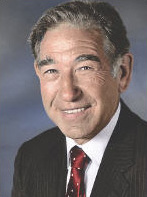Stanley Cohen (biochemist)
Stanley Cohen | |
|---|---|
 Stanley Cohen | |
| Born | November 17, 1922 |
| Nationality | American |
| Alma mater | University of Michigan Oberlin College Brooklyn College |
| Known for | Nerve growth factor |
| Awards | Louisa Gross Horwitz Prize (1983) Albert Lasker Award for Basic Medical Research (1986) Nobel Prize in Physiology or Medicine (1986) Franklin Medal (1987) |
| Scientific career | |
| Fields | Biochemistry |
| Institutions | Vanderbilt University Washington University in St. Louis |
| Thesis | The Nitrogenous Metabolism of the Earthworm (1949) |
| Doctoral advisor | Howard B. Lewis[1][2] |
Stanley Cohen (born November 17, 1922) is an American biochemist who, along with Rita Levi-Montalcini, was awarded the Nobel Prize in Physiology or Medicine in 1986 for the isolation of nerve growth factor and the discovery of epidermal growth factor.[3][4][5][6]
Early life and education[edit]
Cohen was born in Brooklyn, New York, on November 17, 1922. He was the son of Fannie (née Feitel) and Louis Cohen, a tailor.[7][8] Cohen received his bachelor's degree in 1943 from Brooklyn College, where he had double-majored in chemistry and biology. After working as a bacteriologist at a milk processing plant to earn money, he received his Master of Arts in zoology from Oberlin College in 1945. He earned a doctorate from the department of biochemistry at the University of Michigan in 1948.
Research[edit]
Working with Rita Levi-Montalcini (co-recipient of the Nobel Prize in 1986) at Washington University in St. Louis in the 1950s, Cohen isolated nerve growth factor and then went on to discover epidermal growth factor.[9] He continued his research on cellular growth factors after joining the faculty of Vanderbilt University School of Medicine in 1959. His research on cellular growth factors has proven fundamental to understanding the development of cancer and designing anti-cancer drugs.
Cohen also received the Louisa Gross Horwitz Prize from Columbia University together with Rita Levi-Montalcini in 1983 and the National Medal of Science in 1986.
References[edit]
- ^ Cohen, S.; Lewis, H. B. (1949). "The nitrogenous metabolism of the earthworm (Lumbricus terrestris)". The Journal of Biological Chemistry. 180 (1): 79–91. PMID 18133376.
- ^ Cohen, S.; Lewis, H. B. (1950). "The nitrogenous metabolism of the earthworm (Lumbricus terrestric). II. Arginase and urea synthesis". The Journal of Biological Chemistry. 184 (2): 479–484. PMID 15428427.
- ^ Cohen, Stanley (1993). "Epidermal Growth Factor" (PDF). In Tore Frängsmyr and Jan Lindsten (Eds.). Nobel Lectures, Physiology or Medicine 1981-1990. Singapore: World Scientific Publishing Co. ISBN 978-981-02-0793-9. Archived (PDF) from the original on 2010-12-15.CS1 maint: Extra text: editors list (link) Cohen's Nobel Lecture.
- ^ Raju, T. N. (2000). "The Nobel chronicles. 1986: Stanley Cohen Cohen (b 1922); Rita Levi-Montalcini (b 1909)". Lancet. 355 (9202): 506. doi:10.1016/S0140-6736(00)82069-3. PMID 10841166.
- ^ Shampo, M. A.; Kyle, R. A. (1999). "Stanley Cohen—Nobel Laureate for Growth Factor". Mayo Clinic Proceedings. 74 (6): 600. doi:10.4065/74.6.600. PMID 10377936.
- ^ Weltman, J. K. (1987). "The 1986 Nobel Prize for Physiology or Medicine awarded for discovery of growth factors: Rita Levi-Montalcini, M.D., and Stanley Cohen, Ph.D". New England and regional allergy proceedings. 8 (1): 47–48. doi:10.2500/108854187779045385. PMID 3302667.
- ^ "Stanley Cohen Biography". www.bookrags.com. Archived from the original on 17 November 2017. Retrieved 6 May 2018.
- ^ Sleeman, Elizabeth, ed. (2003). The international who's who 2004 (67th ed.). London: Europa. p. 339. ISBN 978-1857432176. Retrieved 4 May 2016.
- ^ Carpenter, G.; Cohen, S. (1979). "Epidermal Growth Factor". Annual Review of Biochemistry. 48: 193–216. doi:10.1146/annurev.bi.48.070179.001205. PMID 382984.
External links[edit]
- American biochemists
- Members of the United States National Academy of Sciences
- 1922 births
- Living people
- Jewish American scientists
- Jewish chemists
- Jewish physicians
- Nobel laureates in Physiology or Medicine
- American Nobel laureates
- National Medal of Science laureates
- Oberlin College alumni
- Brooklyn College alumni
- Washington University in St. Louis faculty
- Vanderbilt University faculty
- University of Michigan alumni
- Recipients of the Albert Lasker Award for Basic Medical Research